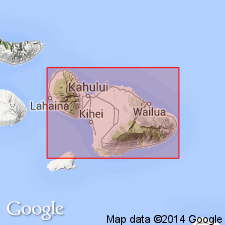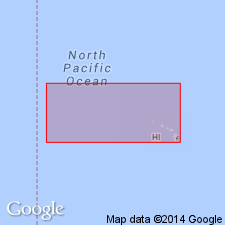
- Usage in publication:
-
- Pauwalu basalt*
- Modifications:
-
- Named
- Dominant lithology:
-
- Basalt
- AAPG geologic province:
-
- Maui
Summary:
Named after Pauwalu Point, Keanae Valley, E. Maui. Included as unit of Hana volcanic series. Well exposed in sea cliff. Composed of dense, fine-grained olivine aa basalt, jointed in columns 6 in to 2 ft in diameter, with layer of clinker at top. Separated into 2 distinct layers by beds of clinker. Is 130 ft thick at sea cliff; 175 ft at Piinaau Falls. Underlies Ohia basalt (new) and sedimentary rocks of Pleistocene age near Pauwalu Point. Also underlies Keanae basalt (new) and Piinaau basalt (new). Unconformably overlies older alluvium that in turn overlies Kula and Honomanu volcanic series. May have been cut during Waipo stand of sea. Map shows middle(?) and late Pleistocene and Recent age.
Source: GNU records (USGS DDS-6; Menlo GNULEX).

- Usage in publication:
-
- Pauwalu basalt*
- Modifications:
-
- Age modified
- AAPG geologic province:
-
- Maui
Summary:
Type locality: Pauwalu Point at mouth of Keanae Valley [20 deg 51' 39"N, 156 deg 08' 04"W, Keanae 7.5' quad] northern coast of Island of Maui HI. Assigned Pleistocene(?) age based on relationship to other units of Hana volcanic series [oldest Hana volcanic series in valley].
Source: GNU records (USGS DDS-6; Menlo GNULEX).

- Usage in publication:
-
- Pauwalu Basalt†
- Modifications:
-
- Abandoned
- AAPG geologic province:
-
- Maui
Summary:
Pauwalu Basalt of Stearns and Macdonald (1942) abandoned as formally named unit and called Pauwalu flow of Hana Volcanics. Hana Volcanics assigned Pleistocene(?) and Holocene age.
Source: GNU records (USGS DDS-6; Menlo GNULEX).
For more information, please contact Nancy Stamm, Geologic Names Committee Secretary.
Asterisk (*) indicates published by U.S. Geological Survey authors.
"No current usage" (†) implies that a name has been abandoned or has fallen into disuse. Former usage and, if known, replacement name given in parentheses ( ).
Slash (/) indicates name conflicts with nomenclatural guidelines (CSN, 1933; ACSN, 1961, 1970; NACSN, 1983, 2005, 2021). May be explained within brackets ([ ]).

